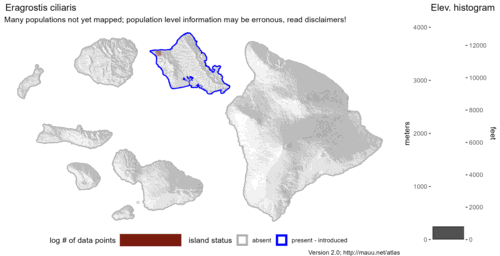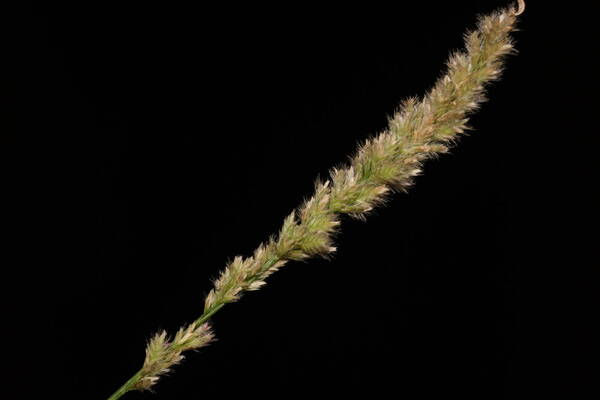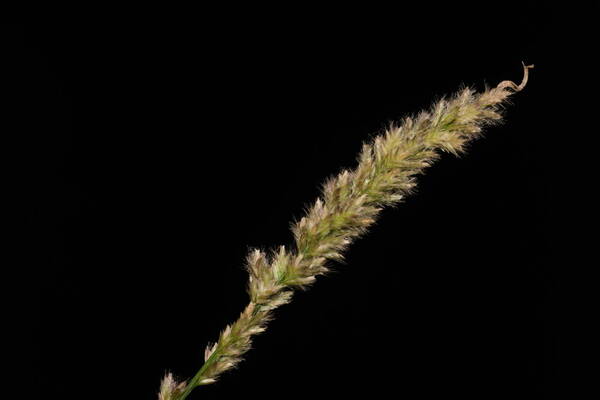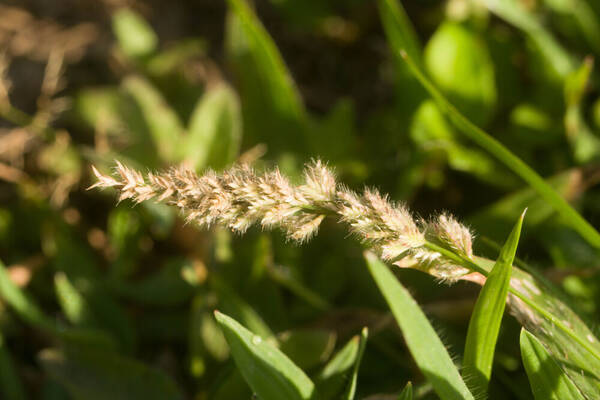Info
Subfamily: Chloridoideae
Genus etymology: Eragrostis = "love grass" [Greek] unclear origin, other etymologies such as "early grass" or "very grass" have also been speculated
Species etymology: ciliaris = "eyelash" [Latin] refering to the hairs on the margins of the palea
Photosynthetic type: C4 (warm season)
Nativity: naturalized - accidental
First recorded in Hawaiʻi: 1976
Map

Inflorescence



Description
Tufted annual; culms 5–60 cm. high, erect. Leaf-blades flat, up to 12 cm. long and 5 mm. wide. Panicle spike-like, but often ± lobed or interrupted, 1–20 cm. long, woolly, the spikelets densely clustered. Spikelets 6–12-flowered, ovate, 2–4.5 mm. long, fluffy, often purplish, breaking up from the apex, the rhachilla fragile; glumes lanceolate, subequal, 0.7–1.2 mm. long, acute; lemmas oblong-elliptic, 0.9–1.5 mm. long, the keels (at least in the upper lemmas) bearing a few short stiff hairs, otherwise smooth, broadly obtuse, ± obscurely mucronate; palea-keels tuberculate-ciliate, the hairs 0.6–0.7 mm. long, exceeding the width of the adjacent floret; anthers 2, 0.2 mm. long. Caryopsis ellipsoid, 0.3–0.5 mm. long. Fig. 60/2, p. 190.
(Description source: Clayton, W.D. 1970. Flora of Tropical East Africa. Gramineae (Part 1). Crown Agents for Oversea Governments and Administrations, London. 176 pp. )
Annual up to 50 cm high; leaves flat. Panicle 1–12.5 cm long, contracted, spike-like or lobed and interrupted. Spikelets oblong-elliptic to ovate, 2–3.5 mm long, 6- to 12-flowered, the florets loose and divergent, covered by the spreading palea-hairs, disarticulating between the florets, the rhachilla fragile; glumes equal, lanceolate, 0.9–1 mm long; lemmas oblong in profile, thinly membranous, 0.9–1.5 mm long, with a few pectinate hairs on the lower part of the keel at least in the upper lemmas, broadly obtuse, mucronate; palea-keels pectinate-ciliate with tubercle-based hairs 0.4–0.8 mm long; anthers 2, 0.1–0.2 mm long.
(Description source: Cope, T.A, (1995) Flora Somalia, Vol 4. Royal Botanical Gardens, Kew, London. 312 pp. )
Loosely caespitose annual; culms up to 60(75) cm tall, erect or ascending, usually unbranched, glabrous at the nodes, eglandular; leaf sheaths eglandular; ligule a line of hairs; leaf laminas 5–20 cm × 1–3(5) mm, linear, flat or involute, glabrous or with scattered long silky hairs, scaberulous, somewhat firm.Panicle 4–20 cm long, woolly, narrow and spike-like but often lobed and interrupted, the spikelets densely clustered on pedicels 2–4 mm long, the primary branches not in whorls, terminating in a fertile spikelet, glabrous in the axils, eglandular.Spikelets 2–4.5 × c. 2 mm, ovate, strongly laterally compressed, 6–12-flowered, the florets disarticulating from the apex downwards, the rhachilla fragile; glumes subequal, 0.7–1.4 mm long, reaching to beyond the middle of the adjacent lemmas, lightly keeled, narrowly lanceolate or narrowly oblong-lanceolate in profile, scabrid on the keel, acute at the apex; lemmas 0.9–1.5 mm long, keeled, oblong-elliptic in profile, membranous with distinct lateral nerves, widely diverging from the rhachilla (greater than 45°), those in opposite rows not imbricate, the rhachilla visible between them, purplish, with a few short stiff hairs on the keel below (most apparent in the uppermost lemmas), otherwise smooth, broadly obtuse and ± obscurely mucronate at the apex; palea glabrous on the flanks, the keels slender, wingless, tuberculate-ciliate with hairs 0.6–0.7 mm long; anthers 2, 0.2–0.4 mm long.Caryopsis 0.3–0.5 mm long, elliptic.
(Description source: Pope, G.V. (ed). 1999. Flora Zambesiaca. Volume 10. Part 2. Kew, London. 261 pp. )
Plants annual; tufted, without innovations, without glands. Culms (3)9-75 cm, erect or geniculate in the lower portion, not rooting at the lower nodes, glabrous. Sheaths hairy on the margins and at the apices, hairs to 4 mm; ligules 0.2-0.5 mm; blades 1.8-12(15) cm long, 2-5 mm wide, usually flat, occasionally involute, glabrous or ciliate basally. Panicles 1.7-15 cm long, 0.2-5 cm wide, cylindrical, contracted or open, branches usually forming glomerate lobes, sometimes more open, often interrupted in the lower portion; primary branches 0.4-4 cm, appressed or diverging to 50° from the rachises; pulvini usually glabrous, occasionally sparsely pilose; pedicels 0.1-1 mm, erect, shorter than the spikelets, glabrous. Spikelets 1.8-3.2 mm long, 1-2 mm wide, elliptical-ovate to ovate-lanceolate, yellowish-brown, sometimes with a purple tinge, with 6-11 florets; disarticulation basipetal, glumes peristent. Glumes ovate to lanceolate, keels scabridulous, veins commonly green, apices acute; lower glumes 0.7-1.2 mm; upper glumes 1-1.6 mm; lemmas 0.8-1.3 mm, elliptical-ovate to lanceolate, membranous, keels scabridulous, lateral veins evident, apices obtuse to acute; paleas 0.8-1.3 mm, membranous, keels prominently ciliate, cilia 0.2-0.8 mm, apices obtuse to acute; anthers 2, 0.1-0.3 mm, purplish. Caryopses 0.4-0.5 mm, ovoid, reddish-brown. 2n = 20, 40.
(Description source: Barkworth, M.E., Capels, K.M., Long, S. & Piep, M.B. (eds.) 2003. Flora of North America, north of Mexico. Volume 25. Magnoliophyta: Commelinidae (in part): Poaceae, Part 2. Oxford University Press, New York. 783 pp. http://floranorthamerica.org/Eragrostis_ciliaris )